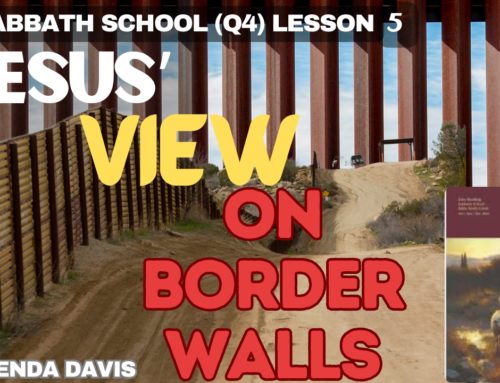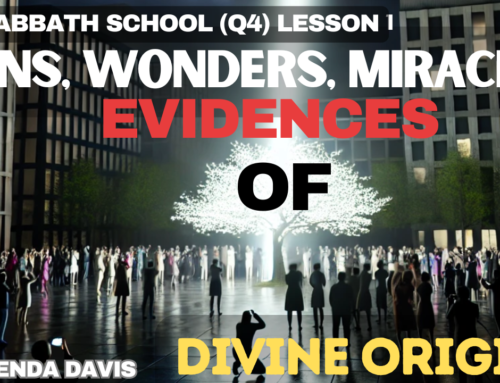“TEAR DOWN THAT WALL!”
What would life look like if the wall of prejudice and racism was demolished? Can that wall be torn down?
In this series, we are studying the Book of Ephesians. Paul wrote Ephesians as a letter to the churches in Ephesus. The Ephesians were Gentiles (Non-Jews) who had accepted Christ. He wrote the letter to encourage these converted Gentiles not to lose hope despite their opposition.
This week we look at Ephesians 2:11-22 which addresses the divide, the wall or petition that caused a separation between the Jews and the Gentiles. Here we address the role that Christ played in dismantling the wall that humans have built that has caused a separation between different people groups.
You may view our past and present videos at SabbathSchoolDaily.com.
You can obtain the study guide for this series at Sabbath.School or ssnet.org, all of which are at no cost to you.
Let Us Invite God’s Presence:
Holy Father, our world has been deceived by the enemy. Satan has led some to believe they are superior to others. Help us to see each other as one family. In Jesus’ Name, Amen.
The separation between groups of people is not new. Division among humans has existed since sin entered this world. This wall existed even when Jesus came to the earth as a man. However, after his conversion, Paul became an advocate for tearing down the wall of separation. Paul, in Ephesians 2:14-15, lets us know that Jesus came to tear down this wall. What does Paul say that Jesus did to tear down this wall?
14 For He Himself is our peace, who has made both one, and has broken down the middle wall of separation,
15 having abolished in His flesh the enmity, that is, the law of commandments contained in ordinances, so as to create in Himself one new man from the two, thus making peace (Ephesians 2:14-15).
Was Paul talking about the wall with all its warning signs that we talked about in the previous video?
This wall created a separation between Jews and Gentiles who were non-Jews. A separation existed between the two because one group, the Gentiles, worshipped many little gods, and the Jews worshiped One God, the creator of the Universe.
However, many of the Gentiles gave up their many gods, accepted Jesus, and worshipped the One God, the God who created Heaven and Earth. But there was still this division between the Jewish Christians and Non-Jewish Christians.
Both groups were Christian; they both had accepted Jesus as their Savior. But there was this division among them. Thus, the Non-Jews were prohibited from worshipping in the Jewish Temple. There was a literal wall of separation between them.
Was this the wall Paul was talking about breaking down so that non-Jews could worship God together with the Jews? Most likely. Paul, in Ephesians 2:18, expresses that this wall was no longer necessary. Why?
18 For through Him we both have access by one Spirit to the Father. (Ephesians 2:18).
Paul’s point was the Cross removes all the walls between God’s people. In other words, Jewish Christians and non-Jewish Christians were to no longer be a separate group of people but one group.
However, some seem to think Ephesians 2:14, 15 implies that God dismantled the Ten Commandments. But it is evident that Paul was not referring to the Ten Commandments when he talked about the wall of separation being torn down.
The ten commandments advocate unity, not disunity.
As a matter of fact, Paul had great respect for God’s law, the ten commandments. He saw the ten commandments as a guide for Christian living. Paul refers to the laws in the Ten Commandments many times.
For instance,
- Paul talks about the 5th commandment regarding honoring our father and mother in Ephesians 6:2, 3.
- He refers to the 7th commandment regarding infidelity, cheating, or adultery in Ephesians 5:3–14, 21–33.
- He addresses the 8th commandment, which deals with stealing in Ephesians 4:28,
- He refers to the 9th commandment, which relates to lying in Ephesians 4:25
- And he addresses the 10th commandment related to coveting in Ephesians 5:5. Coveting is having the intense desire to have what someone has.
Paul does, however, address the issue of using the law as a mechanism of control. But on the other hand, we can certainly see that Paul valued God’s ten commandments. This is evident in Romans 3:31 and Romans 7:12
Romans 3:31
31 Do we then make void the law through faith? Certainly not! On the contrary, we establish the law. (Romans 3:31)
Romans 7:12
12 Therefore the law is holy, and the commandment holy and just and good. (Romans 7:12)
So, the problem isn’t the law, the ten commandments. The problem is with people who use the law to advantage themselves and cause division. But does that make the law bad?
The point is, we do not throw the law, God’s ten commandments, out just because people teach wrong things about it.
Paul shows respect for the law of God and says they continue forever. So, what was Paul saying in Ephesians 2:14 -15?
Paul is expressing opposition to those trying to use the law to separate Jewish Christians and non-Jewish Christians. Separation is not a plan for God’s people.
Furthermore, the word “law” in Ephesians 2:14, 15 is not referring to God’s ten commandments. It is referring to the laws concerning animal sacrifices, ordinances, and the Old Testament system of worship that God gave them that point to the coming Messiah, the anointed one, Jesus Christ.
However, the Jewish leaders used this system of worship to create division between the Jews and the non-Jews. But for those who accept Christ, there is no division. There is no need for sacrifices of goats and bulls. Jesus is our sacrifice. He has torn down the wall that separates us. Rather than encouraging separation, what did Jesus advocate while ministering on earth? Read Ephesian 2:11-22
Then continue to the next section of this Video, Part 5: Jesus, Preacher of Peace
Ephesians
(Lesson 5)
The Cross and the Church
Part 5: Jesus, Preacher of Peace
Paul, in Ephesians 2:17, 18, summarizes Jesus’ work on earth as a ministry of peace. He advocated unity.
And based on his letter to the Ephesians, Paul continued in the footprint of Jesus. In his Letter to the Ephesians, we see that peace is an important issue in his letter. He begins his letter in Ephesians 1:2 by saying:
2 Grace to you and peace from God our Father and the Lord Jesus Christ. (Ephesians 1:2).
And he ends his letter to the Ephesian with a similar statement saying in Ephesians 6:23
23 Peace to the brethren, and love with faith, from God the Father and the Lord Jesus Christ. (Ephesians 6:23)
And notice that in Ephesians 2:11–22, Paul in Ephesians 2:14–16 argues that peace is personified in Jesus. Jesus Himself is our peace! Because Jesus is peace when we accept him as our Savior, He destroys the wall between us, and the Cross gives us peace.
When we accept Jesus, we are made brand new, our hearts are changed, and we are transformed into his likeness. We desire what he wants. Therefore, the peace that Jesus gives is not just the absence of conflict. The peace that Jesus gives aligns with the Hebrew concept of shalom. It renews our friendships and fills our hearts with love. The peace that Jesus, as Paul expresses in Ephesians 2:15–17, brings about reconciliation. The peace Jesus brings about wholeness and well-being. It gives us peace with God and others.
This message of peace that Paul gives to the Ephesians is not limited to just them: Paul also addresses the issue of peace in the following verses.
Romans 10:14-15
14 How then shall they call on Him in whom they have not believed? And how shall they believe in Him of whom they have not heard? And how shall they hear without a preacher?
15 And how shall they preach unless they are sent? As it is written: “How beautiful are the feet of those who preach the gospel of peace, Who bring glad tidings of good things!” (Romans 10:14, 15 )
Paul is referring to Isaiah 52:7 and 19
7 How beautiful upon the mountains Are the feet of him who brings good news, Who proclaims peace, Who brings glad tidings of good things, Who proclaims salvation, Who says to Zion, “Your God reigns!” (Isaiah 52:7)
Isaiah 57:19
19 “I create the fruit of the lips: Peace, peace to him who is far off and to him who is near,” Says the Lord, “And I will heal him.” (Isaiah 57:19)
Moreover, The Gospels, the first four books of the New Testament (Matthew, Mark, Luke, and John), contain examples of Jesus as a preacher of peace.
For example, in Jesus’ final sermon to His disciples, in John 14:27, He promises them (and us) peace, saying,
“ ‘Peace I leave with you, My peace I give to you’ ” (John 14:27).
Jesus then ends His sermon with these words:
33 These things I have spoken to you, that in Me you may have peace. In the world you will have tribulation; but be of good cheer, I have overcome the world.” (John 16:33).
After Jesus’ resurrection, when He woke up from the dead, He appeared to His disciples. Again, He tells them in John 20:19, 21, 26, “ ‘Peace be with you!’ ”
In Ephesians 2:17, 18 and Ephesians 2:11–13, Paul makes it clear that Jesus’ message of peace was for both the Jews and non-Jews and that it extends beyond the time of Jesus’ ministry on earth.
Therefore, all believers who accept Jesus and adhere to Paul’s proclamation about the peace that comes from Jesus experience the wall between them and their fellow believers destroyed.
In the place of alienation and separation, they receive an amazing blessing. What is that blessing?
Continue to Part 6: The Church, a Holy Temple
Ephesians
(Lesson 5)
The Cross and the Church
Part 6: The Church, a Holy Temple
So, Ephesians 2:1–10 teaches us that because of the cross, when we accept Jesus, we can have peace. We can live in harmony with God.
Furthermore, Ephesians 2:11–22 teaches us that we may live in peace and in unity with our fellow brothers and sisters in Christ. Not only does Jesus’ death on the cross allow us to have peace, but it also heals our broken relationships with others.
Through the cross, Jesus has demolished, He has broken down every wall causing separation between Jews and Gentiles.
After Jesus broke down the walls that separated His people, He built an amazing new “temple”: this temple is symbolic. It represents all Christians, It represents all followers of Jesus Christ. This temple is His church.
Before Jesus died on the cross, Gentiles (non-Jews) couldn’t worship in the holy parts of the physical temple. But after Jesus rose from the dead, He destroyed the wall between them.
Therefore, together, these two separate groups became a new temple. Christians today become part of God’s church, his temple.
This is the point that Paul makes in Ephesians 2:19–22 when he uses the phrase “a holy temple in the Lord”. As a holy temple of the Lord, we live in harmony and peace with Jesus and our brothers and sisters in Christ.
In short, Jesus’ death has both vertical benefits and horizontal benefits.
The vertical benefit, Ephesians 2:1–10: Jesus’ death establishes our relationship with God.
The horizontal benefit, Ephesians 2:11–22: Jesus’ death establishes our relationships with others.
In other words, Through the Cross, Jesus demolishes all the divides between Gentile believers and Jewish believers, including the misuse of the Law that was used to widen the separation between them.
In Ephesians 2:19–22, Paul uses the metaphor of a temple.
This same metaphor is used in:
1 Corinthians 3:9–17;
2 Corinthians 6:14–7:1;
and 1 Peter 2:4–8.
Paul’s purpose in using the image of the church as a temple is designed to show the full inclusion of Gentiles in the church.
Paul points out that though once banned from worshipping in the “Court of Israel,” the temple, they now not only gain access, but the Gentiles also became the same as living bricks or stones that God uses to build His new temple on earth.
This temple Paul expresses in Ephesians 2:22 is a place where God lives by His Spirit in the hearts of His people.
It is important to know that New Testament writers used the temple as a metaphor to help us understand that God’s church is holy. It has been set apart for His divine purpose. God is the One who starts and builds His church (Ephesians 2:22).
God’s followers in His church are to live in peace and harmony with each other. God’s temple is living. It is composed of living bricks that are cemented together.
Therefore, regardless of race, culture, gender, social status, or education, we are united in Christ. Christ has destroyed the wall that separates us.
If you are not a member of this body, why not join it today? Accept Christ and become a living stone cemented by the Cross to other living stones that move in harmony with each other.
Through the cross, we are united in Jesus Christ!
——————————————————–
Thank you for watching this video. To be notified when our next video comes out, click the subscribe button below. If you found this video beneficial and desire to participate in sharing, click share so that your friends and family can benefit from it as well. Thank you for sharing and subscribing.
Hebron Seventh-day Adventist Church
7902 Wheatly Street
Houston, TX 77088
Watch Past and Present Lessons at SabbathSchoolDaily.com



